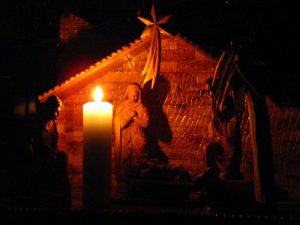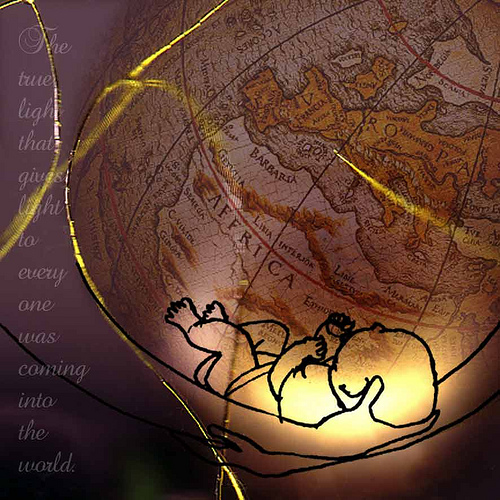Lectionary Reflection for the Second Sunday of Christmas
January 5, 2014
The light shines in the darkness, and the darkness did not overcome it. John 1:5
Shepherds, angels, wise men–John will have none of these to open his gospel. No, his is no homespun tale of a babe in the hay, a star that draws foreign travelers, and a pondering teenage virgin mother. John paints with broad brush strokes and vivid color. He wants to give us the big picture and the grand design of Jesus’ incarnation. John’s gospel is like a Spielberg spectacular compared to Matthew’s and Luke’s Disney version of Jesus’ birth story. With John, everything is writ large, no metaphor or image is spared, and awe, mystery, and wonder are the evoked responses this gospel writer seeks.
From the very first verse, the cosmic powers of light and darkness are defined, and the stage is set for a drama of eternal import. The language is lovely, and the message is clear: This Jesus, God dwelling among us, is the real deal. Listen up! Pay attention! You won’t want to miss a millisecond of the action. Yes, signs and wonders will point to John’s vision of Jesus throughout the gospel. This dear, friends, is potent stuff.
 Granted, many in the pews this Sunday will recall most of this reading as that which precedes the lighting of the candles during the Christmas Eve service–a warm and fuzzy part of the liturgy indeed. Unfortunately, most folks have long since moved on from that holy night and returned to the rhythms of the workaday world. So what makes today’s emphasis different? How can we help people to hear these marvelous verses apart from a silent night?
Granted, many in the pews this Sunday will recall most of this reading as that which precedes the lighting of the candles during the Christmas Eve service–a warm and fuzzy part of the liturgy indeed. Unfortunately, most folks have long since moved on from that holy night and returned to the rhythms of the workaday world. So what makes today’s emphasis different? How can we help people to hear these marvelous verses apart from a silent night?
I think the answer, or at least a key answer, is found in the image of Jesus as the light of the world. I mentioned that John’s gospel is something akin to a Spielberg production in its scope and sweep. In film production, light truly is key. The director of photography is the one who “paints with light.” When light is not used well, the entire film suffers. You can’t tell a story via film, video, or even still photography without light. No light. No image.
Film/Church Geek Alert: It’s interesting to note that in cinematography, the standard lighting technique is called “Three Point” because it utilizes three lights to illuminate the subject (key light, fill light, and back light). The geek part of me just loves the Trinitarian image here: one careful illumination using three lights. Sorry, I couldn’t resist.
Light and dark are all around us, so much so that we often forget just how important light is in our lives. Without light, no plants would grow; therefore, we would not eat. Without light, there would be no warmth. Light is essential to our very existence. That’s why John’s reference to Jesus as Word and Light says so much.
Yes, God came to us in the least threatening, comically absurd way possible–a tiny, helpless infant born to a poor, unwed, teenage mother in a small, insignificant land. However, this same God incarnate as Jesus of Nazareth is also eternal Word and true life. Yes, Jesus is not only our  light but our very life. Not one thing on earth and throughout the vast cosmos has evaded his creating, sustaining, and nurturing presence. We may not name him, claim him, or even acknowledge him, yet still his light shines in the darkness, and the darkness of evil, power, hatred, violence, war, anger, and bitterness will never defeat him.
light but our very life. Not one thing on earth and throughout the vast cosmos has evaded his creating, sustaining, and nurturing presence. We may not name him, claim him, or even acknowledge him, yet still his light shines in the darkness, and the darkness of evil, power, hatred, violence, war, anger, and bitterness will never defeat him.
This, dear friends, is very good news. This is the Christmas message not just for a day or for a season, but for all time and for all the world to hear, see, and experience. Jesus is that all-encompassing light and ever-present Word. His grace, mercy, and love are truly worthy of blockbuster status, so throw out all the stops and help people see that no Spielberg, DeMille, Bergman (as wonderful as their films are), or any other filmmaker, can come close to the kind of production the Creator of the Universe continues to bring to life.
In Worship
Garden Planning
If you’re working with the Old Testament Lesson from Jeremiah this week, consider using the garden imagery found in 31:12 for your congregation’s worship. How are our individual life gardens going to be tended this year? What about our congregation’s garden? Will we open ourselves to God’s good tending and cultivating so that an abundant harvest of ministry and blessing pour forth?
If your congregation has or is planning a gardening ministry this year, why not start the new year off with a blessing? Invite anyone involved in the planning to bring gardening tools, bring in some soil from the garden plot and place it in a bowl on the altar, and bless the tools and soil. Ask God to bless your efforts and to cultivate a life “like a watered garden” for each individual and for your corporate life as a congregation.
With Youth
In Plain View and Plainly Overlooked
The incarnation is the irruption of God into human history: an incarnation into littleness and service in the midst of overbearing power exercised by the mighty of this world; an irruption that smells of the stable. The Son of God was born into a little people, a nation of little importance by comparison with the powers of the time. He took flesh among the poor in a marginal area–namely, Galilee; he lived with the poor and emerged from among them to inaugurate a kingdom of love and justice. That is why many have trouble recognizing him.
— Gustavo Gutierrez, writing in The God of Life
Consider using this quote from liberation theologian Gustavo Gutierrez to talk about how easy it is to overlook Jesus among us–both then and now. Why do we still tend to look for Jesus in places of power? Why do we assume that Jesus will be found in popular decision or majority opinion? Where is Jesus today that we plainly overlook him? What evidence of God-with-us can we find in small places and insignificant ways?
With Children
Watt’s Up?
Assemble lights of varying watts and types. I will use a battery-operated Christmas window candle, a halogen lamp, a flashlight, and other assorted light bulbs I can find. I’ll talk a little to the children about how lights are a relatively new thing in history. Before them we used oil lamps, candles, and fires for light. Using a clay oil lamp would be a nice touch to show what light in Jesus’ day looked liked. Tell them that now we can have light with a flip of a switch. When John was writing his gospel, light was much more difficult to come by after the sun set. Jesus as the light of the world would have had an even greater meaning for people in his day. Remind children that oil lamps have to be replenished, fires stoked, and even light bulbs replaced, but the light of Christ never goes away. That’s why many churches have an eternal flame that burns all the time, reminding all who enter the sanctuary that Christ is present, and the darkness will never overcome his light.
Photos: shospace, ineffable_pulchritude, and distar97, Creative Commons. Thanks!




Leave a Reply